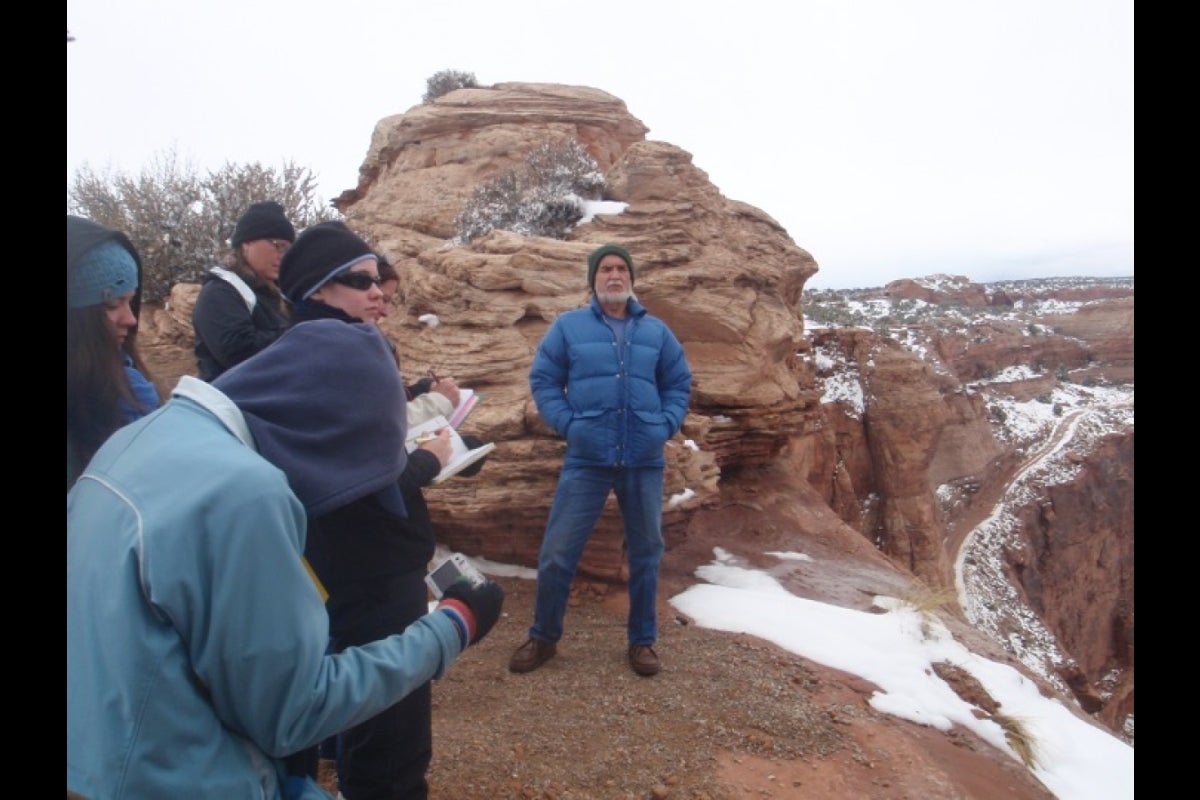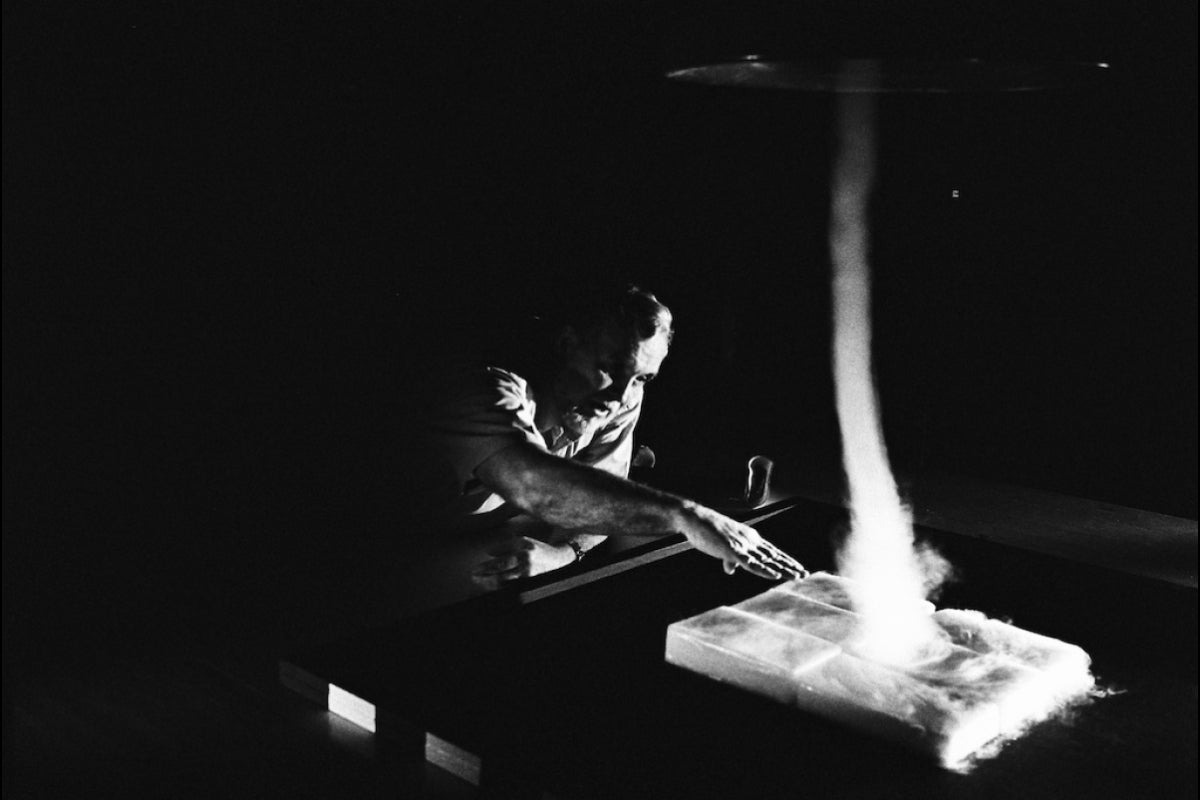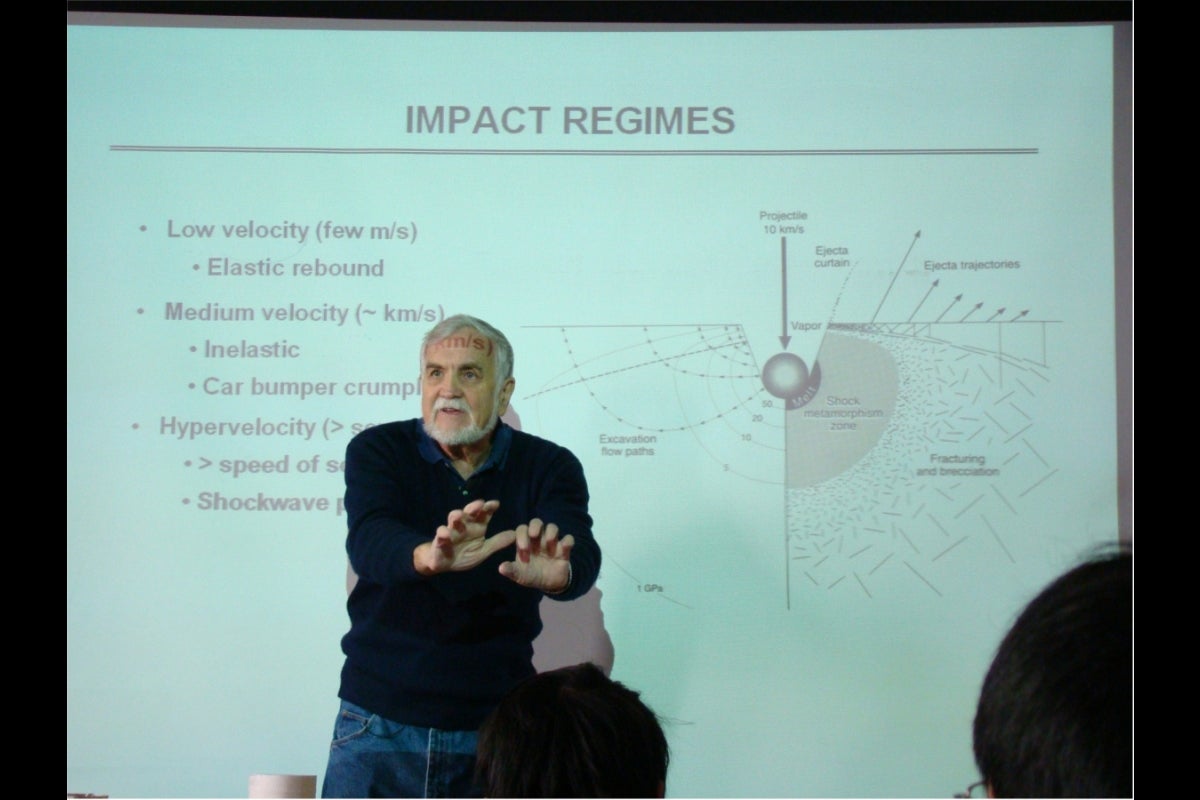The quest to discover life beyond Earth keeps legacy of ASU space professor alive with Europa Clipper mission

ASU Regents Professor Ron Greeley, who died in 2011, presented the Europa proposal at the annual American Association for the Advancement of Science meeting in 2007. Seventeen years later, the Europa Clipper spacecraft is on its way to that icy Jovian moon. ASU photo
Editor's note: The Europa Clipper mission successfully launched Monday at 12:06 p.m. Eastern Daylight Time from Kennedy Space Center's Launch Complex 39A — the same launchpad ASU's Psyche mission used almost exactly one year ago — aboard a SpaceX Falcon Heavy rocket. Read more about the launch on nasa.gov.
Beneath sunny skies Monday at Kennedy Space Center in Florida, NASA blasted the largest planetary spacecraft it has ever built toward an icy moon of Jupiter called Europa. A visionary Arizona State University professor played a big part in getting it to the launchpad.
Ron Greeley died in 2011, but his curiosity lives on through the Europa Clipper mission — nearly two decades after presenting the Europa proposal at the annual American Association for the Advancement of Science meeting in San Francisco.
In 2007, Greeley began advocating for NASA to prioritize the exploration of Europa. Now, the Europa Clipper spacecraft has embarked on its search for potential life beyond Earth. Its mission is to investigate Europa and assess its potential for the building blocks of life, advancing our understanding of habitability within our solar system and beyond.
"Europa is unique in our solar system," Greeley told the group at the American Association for the Advancement of Science that year. "It's a rocky object a little smaller than our moon, covered with a layer of water 100 miles deep."
Europa holds more water than all the oceans on Earth, he explained. Greeley added that Europa also has two other essential ingredients of life: organic chemistry and a source of energy. A mission fulfilling his curiosity is now on its way to the icy Jovian moon.
Joining ASU in 1977, Greeley held a joint professorship in the Department of Geology and the Center for Meteorite Studies, and then headed up the Planetary Geology Group in ASU's School of Earth and Space Exploration. He focused his research on data from early robotic NASA missions and planetary geology. Students and fellow scientists remember his classroom teaching, fieldwork in rugged parts of Arizona, lab work with dry ice and wind tunnels, and his mentorship.
Greeley is considered the father of ASU's space program and received numerous honors, including an asteroid named for him (30785 Greeley) in 1988 and several NASA awards during his exemplary career.
"What struck me most about Ron was what a great teacher and mentor he was," said Meenakshi Wadhwa, director of the School of Earth and Space Exploration. "He always ran the geology field trip where they would go to all of the craters — the volcanic craters and the impact creator in northern Arizona — and the students were always so excited about it, about planetary science and about field geology when they came back from this trip.
"And that's what really kind of sticks in my mind as something that defined Ron — just how caring and just how invested he was in teaching and mentoring students — Bob Pappalardo is a prime example."
Bob Pappalardo is the Europa Clipper mission project scientist. Pappalardo earned his doctorate in geology from ASU in 1994, and Greeley served as his advisor.
After earning his PhD, Pappalardo worked alongside Greeley at ASU for a year on developing the initial plans for Galileo's imaging of Europa. In 2002, the two scientists, now colleagues, worked together on the science basis for Europa mission studies. This collaboration would define the details of the Europa orbiter mission.
Greeley's legacy lives on through Pappalardo and the Europa Clipper spacecraft. The spacecraft, equipped with advanced scientific instruments, will conduct detailed studies of Europa's surface and subsurface, providing valuable data for the mission’s science objectives, and give a full picture of Europa.
NASA has a legacy of carrying inspirational messages on its spacecraft. Europa Clipper is no different. The vault plate on the spacecraft includes a hand-drawn sketch and signature of Greeley, a reminder of his tireless dedication to planetary exploration.
"Because Ron was so influential to the birth of this mission and getting it going so many years ago," Pappalardo said, "Ron will always be watching the progress of this mission as it goes forward, as it orbits Jupiter and makes flybys of Europa. And he'll always be with us, the science and mission teams."
Greeley significantly advanced ASU's space program through his expertise in planetary sciences and experience from training Apollo astronauts. ASU's space program would expand considerably with the hiring of Phil Christensen, now a Regents Professor of geological sciences in ASU's School of Earth and Space Exploration.
In 1981, Greeley hired Christensen, who specifically came to ASU to work for him as a postdoc. Christensen had just won a big NASA contract to build an instrument for a Mars orbiter and would see his 30-plus-year career thrive in the environment Greeley created for geology in the areas of planetary research and space exploration.
Although Greeley didn't build instruments, he laid the foundation for ASU to expand its space program, with the university adding the Interdisciplinary IV (ISTB4) building. In ISTB4, scientists like Christensen can build and test instruments for the space industry and NASA, including the Europa Thermal Emission Imaging System (E-THEMIS) onboard the Europa Clipper spacecraft.
E-THEMIS, led by Christensen, is an infrared camera designed to map Europa's temperatures for the mission. These infrared images will help scientists seek clues about Europa's activity, including regions where Europa's suspected ocean may be near the surface.
"Ron Greeley is one of the key reasons we're going to Europa," Christensen said. "He was active for decades, advocating for the science of planetary exploration in general, but Europa in particular. ...
"It's unfortunate that Ron is not here to share this because I know he would take incredible pride in his role in making this mission happen. And just in watching many of his students, like Bob Pappalardo, who have flourished and become their own and are now leaders in this project, Ron would be extraordinarily proud."
More about the mission
Missions such as Europa Clipper contribute to the field of astrobiology, the interdisciplinary research on the variables and conditions of distant worlds that could harbor life as we know it. Although Europa Clipper is not a life-detection mission, it will conduct detailed reconnaissance of Europa and investigate whether the icy moon, with its subsurface ocean, has the capability to support life. Understanding Europa's habitability will help scientists better understand how life developed on Earth and the potential for finding life beyond our planet.
Managed by Caltech in Pasadena, California, NASA's Jet Propulsion Laboratory leads the development of the Europa Clipper mission in partnership with the Johns Hopkins Applied Physics Laboratory in Laurel, Maryland, for NASA's Science Mission Directorate in Washington, D.C. The Planetary Missions Program Office at NASA's Marshall Space Flight Center in Huntsville, Alabama, executes program management of the Europa Clipper mission.
More information about Europa can be found at europa.nasa.gov.
More Science and technology

Indigenous geneticists build unprecedented research community at ASU
When Krystal Tsosie (Diné) was an undergraduate at Arizona State University, there were no Indigenous faculty she could look to in any science department. In 2022, after getting her PhD in genomics…

Pioneering professor of cultural evolution pens essays for leading academic journals
When Robert Boyd wrote his 1985 book “Culture and the Evolutionary Process,” cultural evolution was not considered a true scientific topic. But over the past half-century, human culture and cultural…

Lucy's lasting legacy: Donald Johanson reflects on the discovery of a lifetime
Fifty years ago, in the dusty hills of Hadar, Ethiopia, a young paleoanthropologist, Donald Johanson, discovered what would become one of the most famous fossil skeletons of our lifetime — the 3.2…




